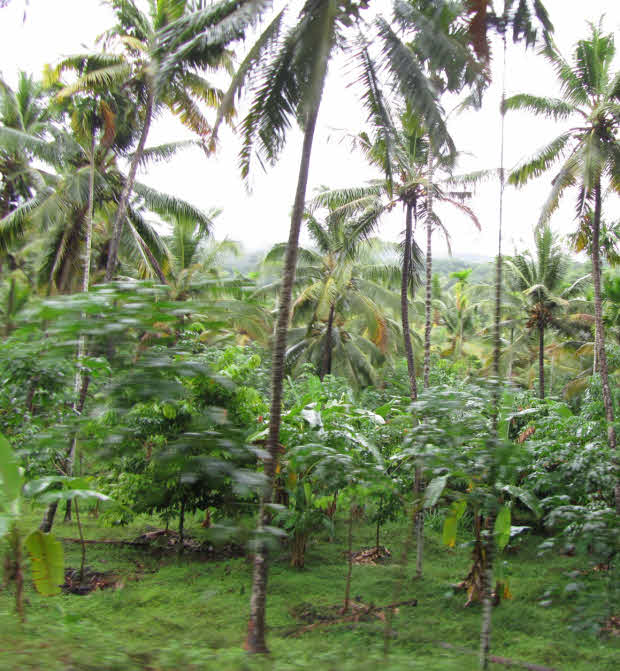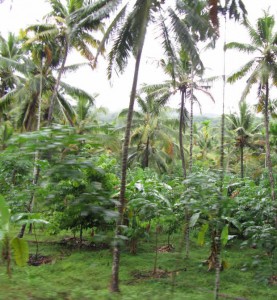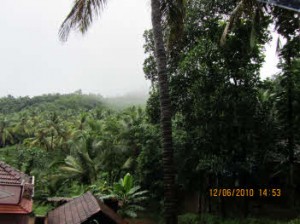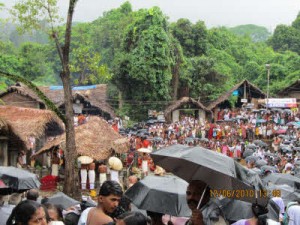by Varsha Sreenivasan
[box]Varsha Sreenivasan takes us on a journey through the beautiful greens of Kerala, to a place called Kottiyoor which boasts of two temple shrines. Read on to know more about the place and the history that precedes it. Text and photographs by Varsha Sreenivasan.[/box]Nestled in the lap of the beautiful Sahya mountains in Kerala, lovingly nurtured by the evergreen Wayanad forests and closely guarded by the intimidating Western Ghats, lies an ancient mystical place called Kottiyoor, reverentially prefixed with the salutation Sri in recognition of its divine status. About 70 km from my hometown of Kannur, Sri Kottiyoor is cocooned within the eastern border of the district, and steeped in centuries-old myth and legend.
The road to this legendary place snakes through lush green landscape bordering the Wayanad forests, depositing you at the banks of the gushing Bavali River. Deep within the green sanctuary on either side of this river and hidden from view are two ancient temple shrines dedicated to Lord Shiva and Goddess Sati. The shrines are called Akkare Kottiyoor and Ikkare Kottiyoor, referring to ‘that bank’ and ‘this bank.’ While ‘this bank’ shrine is accessible to devotees through the year like any other place of worship, ‘that bank’ is open to pilgrims and priests for only 28 days at a specific time annually. The occasion is a cause for celebration for anxious devotees fasting in the period prior to the much awaited opening. They celebrate the event marking the end of their wait as the Vaisakha Maholsavam or the Vaisakha Festival.
If ‘that bank’ is so special to everyone converging in thousands every single day for nearly a month, why then is it shut to all throughout the rest of the year? This has been a source of great wonder to me for quite some time, being one among the countless who share the same deep, inexplicable bond with the place. The mystery still remains, though the history is more commonly available.
It is said that ancient records by scholars describing significant places of pilgrimage and their importance, mention the place of Kottiyoor
as the location of the fire sacrifice performed by King Daksha in ancient times. Texts say this event was brought to a sharp halt when the King’s youngest daughter Princess Sati, the divine consort of Lord Shiva, gave up her earthly form in the sacrificial flames, anguished by the insult of her lord by her father. The story goes that on seeking pardon, the Lord forgave the King and at the behest of the worried Gods, he himself completed the interrupted fire sacrifice or yagna for the benefit of all beings. A grieving Shiva is then said to have taken the form of the Swayambhu or the self-manifested lingam next to the site where Devi Sati offered her mortal form in yogic fire.
This is the event, which many Indians believe, became the trigger for the tradition called simply as Sati – the tradition of the Indian wife offering her mortal being in the funeral pyre of her dead husband, marking the end of their earthly journey together as soul mates. This tradition initially began in ancient times with the voluntary act of renunciation of the form bound to all earthly attachments in yogic fire called yogagni – the fire of awareness of divine unity. Over the years it gradually degraded into a gruesome practice of crime against women, where her immediate society forced the act upon the individual. This custom was prevalent in several parts of India and spread out across the sub continent, until it was officially outlawed in 1829.
But the word Sati means the feminine, the true one. To me, this is the meaning closest to my heart. To me, Sati signifies the innocent daughter true to her father, the impartial wife true to her husband and the enlightened soul true to her knowledge of dispassion and divine unity. To me, Sati signifies divine equilibrium inspiring her father to recognise the failings of ego and vanity; inspiring her lord toward earthly renunciation. To me Sati signifies the heart of all creatures, the quiet silence that speaks as the conscience of every individual, whispering the truth of ego and pride on one end and love and forgiveness on the other, asking it to choose and choose well.
To me, Sati is the divine balance that must be kept, to rescue my soul from the clutches of blind ego, to deliver the ego into the all knowing flames of Supreme Unity of all beings and all creation. Sri Kottiyoor to me like to many of my countrymen, is that mysterious altar that has unmistakeably become my place, my Soul.
[box type=”info”]DID YOU KNOW? The post you just read is also a part of a PDF that can be downloaded! Don’t miss the colourful edition and also the chance of reading it all in one place! To download the May 2011 issue as PDF or to flip and read it like a magazine on the e-reader, please use the buttons below.[/box] [button link=”https://sparkthemagazine.com/wp-content/uploads/2011/05/spark-may-2011.pdf” color=”red”]click here to download the May 2011 issue as a PDF[/button] [button link=”http://issuu.com/sparkeditor/docs/spark-may-2011?mode=embed&layout=http%3A%2F%2Fskin.issuu.com%2Fv%2Fcolor%2Flayout.xml&backgroundColor=000000&showFlipBtn=true” color=”green”]click here to flip and read the May 2011 issue like a magazine[/button] [facebook]share[/facebook] [retweet]tweet[/retweet]








[…] The Call of Kottiyoor […]